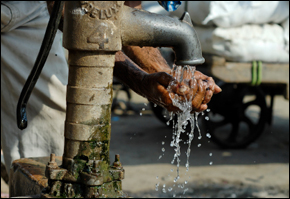Indian Cities Face Sanitation Challenge
A recent survey on sanitation in India’s cities reveals the need for dramatic changes.

Urban sanitation remains poor in India and requires drastic overhaul, despite a year-long campaign to improve public health, Bloomberg reports. None of the 423 cities surveyed by World’ Bank’s Water and Sanitation Program achieved the study’s highest ranking of ‘healthy and clean.’
India’s Ministry of Urban Development commissioned the survey as part of its National Urban Sanitation Policy and Goals launched in November 2008. Goals include the elimination of open defecation, city-wide sanitation, proper management of wastewater and storm drainage, and the proper disposal of solid waste throughout the country’s cities.
The study ranked large cities—containing 100,000 people or more–by using 19 sanitation indicators, including access to community toilets and safe management of human excreta. About one-third of Indians live in urban areas, 18 percent of whom defecate in the open on a daily basis, according to the World Health Organization.
The results of the study found that 40 percent of the cities were in need of immediate repair, while more than half need considerable improvement.
The top-ranked urban centers, including Chandigarh, Mysore and Surat only achieved ‘recovering’ status, the study’s second-highest ranking.
Meanwhile Bangalore and greater Mumbai were ranked 12 and 45 respectively, and categorized as ‘needing considerable improvement.’ Almost 190 of the cities, including Churu, Lakahimpur and Pilibhit, all of which reside in Northern India, were deemed as ‘emergencies’ and in need of immediate repair.
While roughly half of India’s 1.2 billion population has a mobile phone, only 366 million people have access to proper sanitation, according to a 2008 study by the United Nation. Even in the midst of the global economic downturn, India’s growth never dipped below 5.8 percent, according to the Economist. As of 2009, the South Asian country is the fourth largest economy in the world.
But the Indian government realizes the sanitation challenge will need more than just money. The National Urban Sanitation Policy aims to pair infrastructural changes with behavioral changes by increasing citizen awareness of the importance of sanitation.
“It is a tragic irony to think that in India, a country now wealthy enough that roughly half of the people own phones, about half cannot afford the basic necessity and dignity of a toilet,” Zafar Adeel, director of the UN’s Institute for Water, Environment and Health, said in an April press release. Adeel was responding to the UN’s announcement that Millennium Development Goals for sanitation have fallen behind, especially in South Asia.
Sources: Bloomberg, the World Health Organization, the UN, the Economist, the Ministry of Urban Development
For more information on the UN-Water read the Circle of Blue exclusive interview with Zafar Adeel.










Leave a Reply
Want to join the discussion?Feel free to contribute!